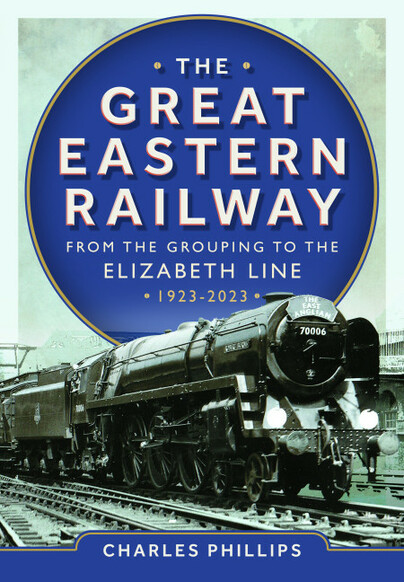Author Guest Post: Charles Phillips
THE GREAT EASTERN RAILWAY FROM THE GROUPING TO THE ELIZABETH LINE 1923 – 2023
The former Great Eastern Railway was at one time seen as a rather dull sleepy railway in the eastern corner of England whose principal traffic was London commuters, holiday makers to the Essex, Suffolk and Norfolk coasts, travelers to the Low Countries and Scandinavia and agricultural produce, but it was and is more so and in particular to those who live and work in the Eastern Counties.
In the years 1923 to 2023 the Railway has seen great changes from a fully steam worked system with a dense network which included the most densely worked suburban system in the world to today’s slimmed down electric and diesel worked system. On the way it has seen the electrification of its suburban system and finally divesting parts of that system to Transport for London, as well as the electrification of its two main lines – to Cambridge and Norwich. But there is more to it than that. Whitemoor Marshalling Yard constructed in Cambridgeshire between 1929 and 1933 was the first fully mechanised marshalling yard in Britain. The Railway was the first in Britain to see a trial of a diesel locomotive, when one ran trials on the line in 1924. Although the Great Eastern was under the shadow of the East Coast Main Line of the LNER it nevertheless did have its own streamline train in the form of the East Anglian in 1937, which may not have reached the heights of the Silver Jubilee, West Riding Limited or the Coronation did give East Anglia a flavour of the streamline age. It is often forgotten that whilst the Southern Railway was the principle participant of the big four companies in the Dunkirk Evacuation of 1940 the GE Section of the LNER also participated, albeit in a small way. Of course the name of Soham and the ammunition wagon explosion of 2 June 1944 will forever be remembered and the efforts of Driver Benjamin Gimbert in saving Soham are commemorated at Soham Village College with the Gimbert Cup for encapsulating the ethos of the school. With the arrival of the Britannia Class locomotives in 1951 to work the principal services out of Liverpool Street the GE Section reached a height that in comparison in relation to the rest of the British railway system has never been reached again. For a short time the GE Section had the fastest train in Great Britain. With the Britannia’s and the new Shenfield electrics to be a railway enthusiast or even just to travel on the GE Section in the early to mid 1950s was an exciting time. From the mid 1950s things got even more exciting so that in September 1962 except for some workings out of March all trains on the GE Section were worked either by diesel or electric traction: the last steam trains arriving and departing Liverpool Street on Sunday 9 September. It is often forgotten that the Liverpool Street to Clacton and Walton-on-the-Naze electrification was the first main line overhead electrification out of London. The Section was greatly savaged under the Beeching Report of 1963, but there was some success against the closures such as the East Suffolk line, but there were also closures that were not in the Report. Although the Section has lost some traffic through the line closures and of that of locals goods yards, it has also gained some in the form of the Port of Felixstowe, which is Britain’s largest container port. The Elizabeth Line, which is London’s newest underground railway uses part of the GE Norwich Main Line from Shenfield to Stratford. In Norfolk the Mid Norfolk Railway, which is one of Britain’s longest preserved railways runs from Wymondham to Dereham. The Great Eastern Railway Society is the finest of the railway historical societies in Britain. Greater Anglia is the current holder of the train operating franchise for the east of England away from the London area and south Essex and has the best trains in the country.
Whilst the Great Eastern Railway of today with all its passenger trains operated either by all electric or dual mode streamlined multiple units and freight trains being mainly container hauled by either electric or diesel locomotives is not the same railway as that of the past, that is not to say that it is a dull railway. Everything has to change and there is a lot to be excited about in this new railway.
Living in mid Essex not far from the London to Norwich main line and being very passionate about the east of England, history and train travel I felt some years ago that there was a need for a new history of the Great Eastern Railway including its ancestors and its successors and so I decided to research and write it. As I did so I discovered that the more I delved the less that I really knew, but I have felt privileged to be able to put in book form in this and its two predecessor volumes a history of the Great Eastern Railway. I hope that the books will be of value to anyone interested in the history of the eastern counties as well those interested in either the railways of Britain as a whole or those of the east of England.

Preorder your copy here.

